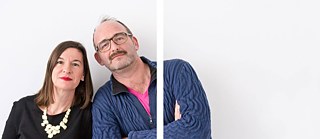The Berlin Design Office Chezweitz
Universes on Demand

The innovative scenography of the exhibition Queer as German Folk comes from the Berlin design office chezweitz, which now supplies the largest and most important museums with its spatial concepts. A home visit.
In the nineties, when there was no Berghain in Berlin and at most a gallery here and there, you went to chezweitz on the weekends. In actuality it was just a student apartment at Berlin's Winterfeldtplatz, but the student's name was Detlef Weitz - and he must have known even back then how to turn a normal room into a galaxy where everyone feels comfortable, inspired and happy.
"We cut hair, partied, and exhibited art," says Weitz today, and his big, bright eyes dream for a moment in the past. "At the weekend it was almost like a bar, an experimental room - that's where the name became established. When I founded the office, I found the name fitting for the things I was going to do.“
What he planned to do - and what he is doing today with his business partner Sonja Beeck and more than 20 employees in two breathtakingly bright Kreuzberg loft floors - is called "museum and urban scenography," and one cannot imagine a better name for the firm that chezweitz. Though Detlef Weitz may have worked as a banker and studied architecture, what he has always been and will be is the perfect host. One who can design the perfect room for every occasion.Today, the office chezweitz is considered one of the best of its kind, and some would say for sure the best ever. The team organizes art and thematic exhibitions for the largest and most important museums, while also developing strategies for, as they say, "the changed perception and use of urban space." Weitz and Beeck are currently working on the scenography of the new permanent exhibition in the Jewish Museum in Berlin, they are preparing the transformation of the Wien Museum and the interior architecture of the Bauhaus Museum in Dessau is also in their hands.
There are different opionions about which project meant the big breakthrough for chezweitz. Weitz's first job after graduation was the design of the Mensch exhibition in the theme park of Expo 2000 in Hannover - one cannot imagine a bigger start. Weitz himself remembers the legendary Pasolini exhibition at the Munich Pinakothek der Moderne in 2004 (P.P.P. - Pier Paolo Pasolini and Tod). "That was a key project," he says. "Because Pasolini was studied as a painter, filmmaker and writer, and we had set the goal to find an individual language for each of these areas." For the film segment, this meant a 12-piece video installation on a total of 400 square meters, which had never been attempted before.You realize that you can create universes using only walls.
With the new exhibition Queer as German Folk, which was created together with the Goethe-Institut and the Schwules Museum Berlin, chezweitz again explores universes through the means of scenography: new perspectives and voices of queer movement history that have not been seen before, were not heard. Historical gaps filled for the first time. An exhibition that can and should be built with the simplest possible means anywhere in the world, which must work in rooms of completely different sizes, even outside a museum setting. "These were extreme conditions," says Weitz. "But that's how creativity develops."
Together with the curators Birgit Bosold and Carina Klugbauer, the idea of the exhibition "on demand" was created, at first rather for fun, as Weitz says. Bosold and chezweitz have known each other since they jointly organized the exhibition Homosexualität_en in the German Historical Museum and the Schwules Museum in Berlin in 2015. Since then, there is unconditional trust. Especially when it comes to breaking new ground.
"We thought this time it would have to work a bit like an online order form - self-printed exhibits that will not hang on the wall, but on coat racks." Only formats that are available globally. T-shirts that become exhibition spaces, printed tapes that tell stories.An experimental room, as before. And like today and tomorrow.